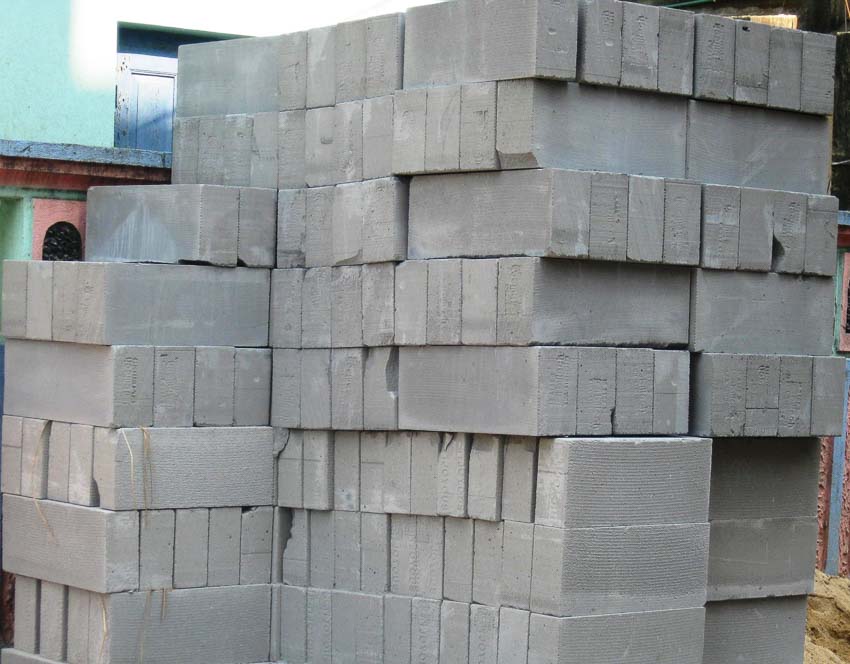The Ultimate Guide to One of the World’s Oldest Building Materials
Concrete is the most commonly used manmade building material in the world. Before your next building project, learn more about this durable material, including the average cost of concrete and why concrete slabs are a favorite for everything from driveways to patios.
What is Concrete Made Of?
Concrete is a mixture of aggregates, cement, and water. Humans have used it for centuries, and scientists continue to make advances in the development of cement. This improves its durability and strength.
Cement
People often use the term “cement” to refer to concrete, but they aren’t the same. So, what is the difference between concrete and cement?
Essentially, cement is one of the key ingredients of concrete. Outside of using it to bond materials together in products like concrete, adhesives, and grout, you don’t use it for much else.
Cement manufacturing starts with calcium carbonate derived from materials like limestone, chalk, and shells. Calcium carbonate from limestone is a readily available material, comprising about 10% of the planet’s surface rock.
When you heat it, calcium carbonate changes chemically into calcium oxide, also known as lime. Next, the process requires that you grind it to a fine powder and combine it with other ingredients to make cement.
These are the most common ingredients in modern cement, present in varying proportions:
| Ingredient | Common name | Percentage | Benefits |
| Calcium oxide | Lime | 60 to 65% | Required for creating calcium silicates |
| Silicon dioxide | Silica | 17 to 25% | Adds strength to the cement |
| Aluminum dioxide | Alumina | 3 to 8% | Helps cement set quickly |
| Magnesium oxide | Magnesia | Up to 2% | Compensates for long-term shrinkage |
| Iron oxide | Ferric oxide | 0.5 to 0.6% | Adds color and strength to cement |
| Calcium sulfate | Gypsum | 0.1 to 0.5% | A small amount promotes optimum hydration |
| Sulfur trioxide | Sulfuric oxide | 1 to 3% | Increases performance and durability of concrete |
| Sodium oxide and potassium oxide | Alkaline | Up to 0.6% | Help control the hydration process and increase the workability of concrete |
Water
When you add water to cement, it forms a paste and an exothermic chemical reaction called hydration occurs. The calcium compounds in the cement bond with the water molecules and transform into calcium silica hydrates (CSH). These hydrates are the reason why concrete is hard and durable.
The amount of water you use in concrete directly affects its strength.
With too little water in concrete, the CSH bonds won’t properly form, and the concrete will weaken. Too much water increases porosity and shrinkage, resulting in weaker concrete.
Aggregates
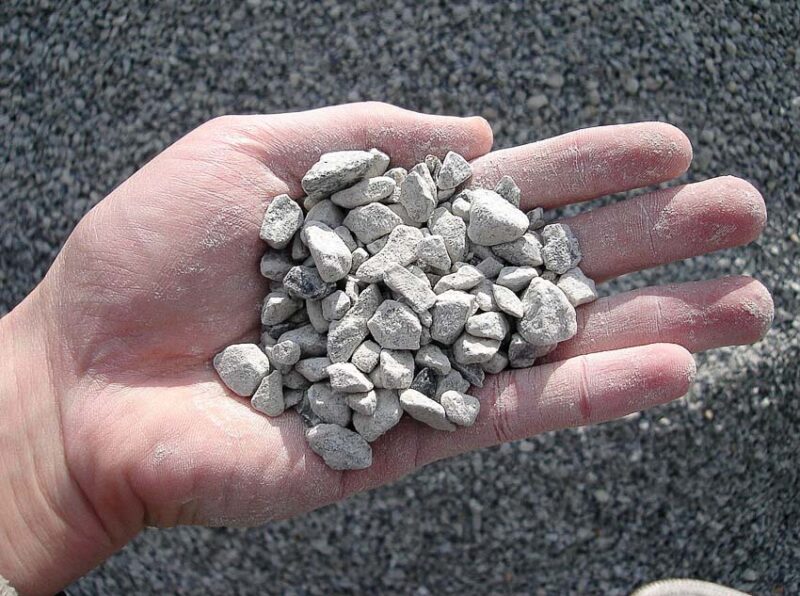
Geological materials like stone or sand particles, or aggregates, help strengthen concrete.
The characteristics of aggregates affect the performance of concrete. Different sizes, moisture contents, and densities of aggregate particles will greatly affect the final product’s appearance, strength, and durability.
Aggregates can also help reduce the cost of concrete. Cement is the most expensive ingredient in concrete, and large aggregate materials help reduce the amount of cement required.
Additives
Many different types of concrete additives improve its structure and workability. These additives, known as concrete admixtures, blend into the concrete during the mixing process. In turn, they impact its strength, setting time, and durability by influencing the chemical bonding process.
Superplasticizers and accelerating admixtures are common concrete additives.
Other additives reduce the amount of water required or slow down the hydration process. These admixtures make working with concrete faster and easier to transport.
Other concrete additives, like concrete dyes and glass fibers, enhance the appearance and strength of concrete used in special applications like countertops and precast architectural panels.
Average Cost of Concrete
You can mix and apply concrete in many different ways, so the average cost of concrete depends on several factors.
Materials that concrete is made of will affect the overall price. Moreover, it will influence the necessary reinforcements, the labor involved, and the type of finish you use. Your project’s purpose, design, and scope will determine all of these factors.
Cost of Concrete Mix: $100-$150 per cubic yard
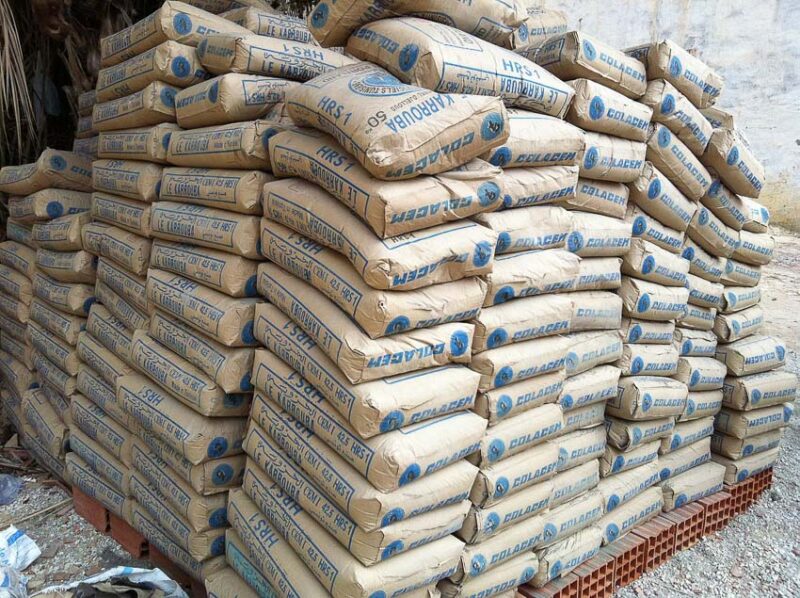
Concrete mix prices vary depending on the strength of the mixture. Building foundations requires concrete with a high psi (pounds per square inch). However, your concrete doesn’t need to be as strong if you’re building a patio or sidewalk.
Concrete with a psi of less than 2,000 is the minimum that you can use on simple surfaces. Driveway slabs and building foundations require a psi of about 3,500 to 4,000, and tall buildings and bridges require 5,000 psi.
The higher the psi, the more you will pay for the concrete. The concrete mix starts at about $100 per cubic yard and can go up to $150 per cubic yard for a mixture with a psi of 5,000.
Stamped Concrete: $8-$18 per square foot
Stamped concrete, also called imprinted concrete, is textured and dyed to look like stone, wood, brick, or slate.
With stamped concrete, you have more color, style, and design choices than with pavers or bricks. Stamped concrete is an economical choice for patios, sidewalks, and driveways, costing between $8 and $18 per square foot.
Cost of Concrete Pavers: $4-$8 per square foot
Like stamped concrete, pavers are useful for patios and driveways. However, pavers are stronger and more resistant to weather extremes than slabs and imprinted concrete.
Concrete pavers are one of the most popular materials used for paving, and you can customize them to achieve a variety of styles and designs. They are inexpensive at $4 to $8 per square foot, but installation costs will add about $10 to $25 per square foot to your final project cost.
Concrete Slab: $3-$5 per square foot
A concrete slab is the least expensive concrete project. It’s also one of the easiest for DIY installations.
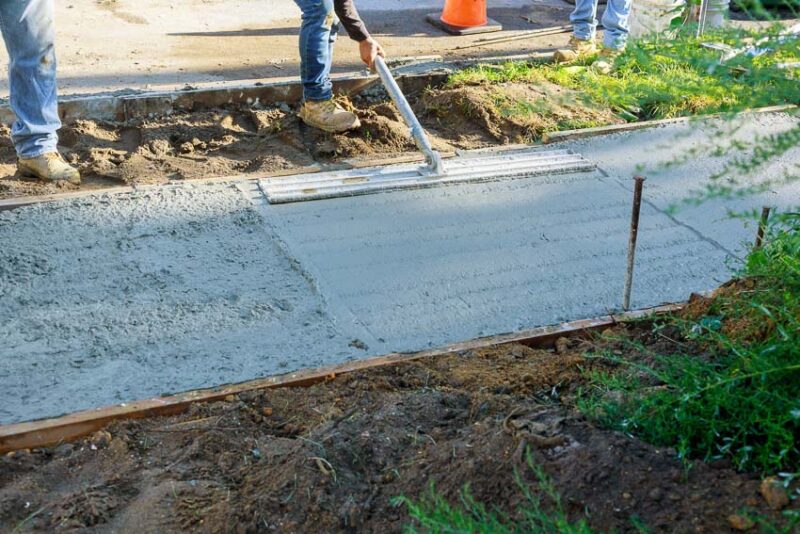
Most concrete slabs are 4 to 6 inches thick and cost about $3 to $5 per square foot. If you hire a professional, the labor costs for installing a concrete slab will add an additional $2 to $3 per square foot.
With the right DIY skills, you can save money and pour your own concrete slab.
Cost of Concrete Block Wall: $7-$12 per square foot
Concrete blocks are an excellent choice for building and landscaping, and prices vary depending on the type of project.
You can use many types of concrete blocks for constructing everything from basement walls to retaining walls and concrete fences. Expect to pay between $7 and $12 per square foot for a concrete block wall, not including installation.
Alternatives to Concrete
While concrete is useful for many projects, it’s not the only material that will do the job. Depending on what you are building, you can choose alternatives to concrete to reduce the cost of your project or create a different look.
Asphalt
For driveways and walkways, asphalt is an excellent alternative to concrete. Even though it’s slightly less durable, asphalt will still last at least 30 years if you maintain it. Moreover, it’s less than half the cost of concrete, making it an economical choice.
Compared to concrete driveways, which cost about $4 to $15 per square foot to install, the national average for asphalt driveways is about $3 to $5 per square foot.
Gravel
Gravel can be used in place of concrete on patios, walkways, and driveways.
Even though gravel driveways require more maintenance than asphalt or concrete, they are still cost-effective in the long run. You can use a variety of edgings and different colors of gravel to create a sleek look that will improve your home’s curb appeal.
The price of gravel and installation varies depending on the depth, the type of gravel, and the amount of site preparation required. However, the average cost to install a gravel driveway is less than $2 per square foot, making it one of the cheapest driveways to install.
Pavers
There are many different types of pavers, including stone, brick, and concrete pavers.
Depending on the availability of these products in your area, the initial cost of pavers is often higher than concrete. Still, pavers are less likely to crack and are sometimes a more durable option than concrete.
The most common types of pavers are natural stone, bricks, and manufactured concrete pavers.
You can use natural stone for projects like edging, patios, and walkways. Meanwhile, you can use new or recycled bricks in place of concrete in walkways and outdoor fireplaces and fire pits. Concrete pavers come in many different shapes and sizes for a variety of applications.
The cost of pavers varies depending on the type and availability in your region, but the average cost is between $4 and $20 per square foot.
Wood
It’s hard to beat the flexibility, versatility, and sustainability of wood as a building material. While it’s not as durable as concrete, it’s still considered an ideal material that can withstand a wide range of temperatures and conditions.
Instead of concrete, you can use treated wood for walkways and patios. It costs about $3 to $8 per square foot, not including installation.
Why People Want Concrete Slabs
If you’re wondering why concrete slabs are so popular, it’s because they are inexpensive and easy to install and maintain. Concrete slabs cost less than many other building materials, and you can use them in a variety of applications, including building foundations, driveways, and patios.
Durability

Concrete slabs will last for decades in high-traffic areas.
To put the durability of concrete into perspective, consider the world’s tallest dam, the Hoover Dam . Made from concrete, it is over 726 feet tall and holds back a maximum pressure of 45,000 pounds per square foot at its base.
Concrete is also long-lasting.
The oldest known concrete, which was found in a hut in Israel, dates back to about 7,000 BCE. Closer to modern times, the Roman Pantheon is almost 2,000 years old and is the world’s largest unreinforced concrete dome.

While modern concrete slabs will only last about 50 years before they start to break down, they are still one of the most durable building materials available.
Versatility
Because you can form concrete into many different shapes, it is a versatile building material. Suitable for many indoor and outdoor projects, you can stain concrete slabs, and also seal them, or etch them with acid. You can also paint them.
You can use a variety of textures and imprints to make concrete appear like natural stone, bricks, pavers, and wood. Moreover, you can create an infinite number of styles with concrete by employing different designs, colors, aggregates, and patterns.
Low Maintenance
Once you install them, concrete slabs require minimal maintenance.
Properly sealed, concrete slabs are resistant to staining, and if you keep them free of debris and weeds, they will continue to look their best for many years. What’s more, you can resurface them to look new again.
Affordability
Concrete slabs are a popular choice for budget-conscious homeowners.
Because they are easy to install, the labor costs are much lower with a concrete slab than with other building materials, like pavers or bricks. And even though concrete slab driveways cost more upfront than other materials, you can save money on maintenance and replacement costs.
Aesthetics
Concrete can enhance the look of any property, and the natural look of a concrete patio can be the base for a variety of trendy styles. Because concrete is so versatile, its appearance can be enhanced to achieve a variety of designs that blend well with any home exterior.
The Cost of Concrete FAQs
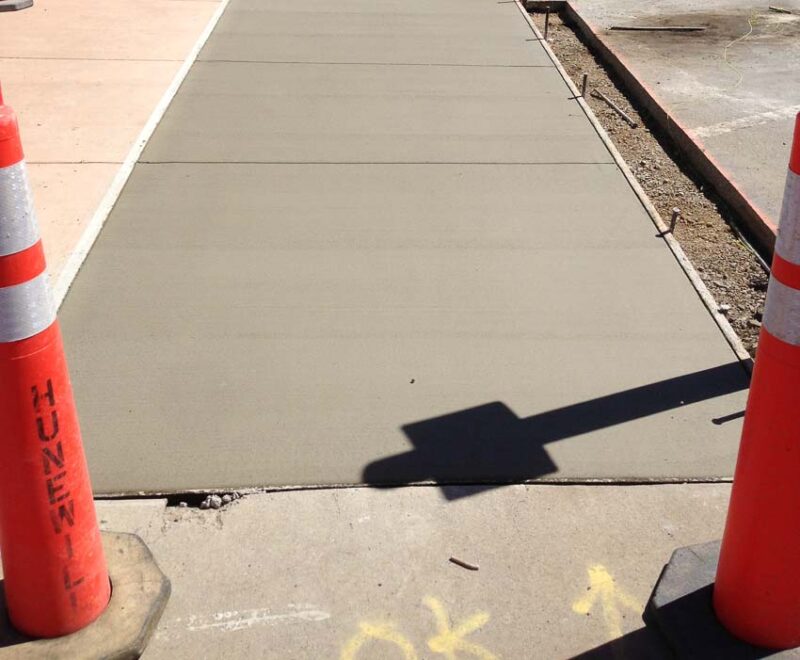
What is the cost of concrete per square foot?
The average cost of concrete per square foot is $4 to $8, but the actual cost of a concrete project depends on several factors. Installation, site preparation, and finishing techniques all add to the cost of concrete.
How long does concrete last?
Concrete lasts an average of 100 years when properly maintained, but many concrete applications will start to crack and crumble after about 50 years. The actual lifespan of concrete depends on how it is mixed.
Ancient Roman concrete buildings are still standing today because of lime clasts. The lime clasts, which are the white lime specks found in these old concrete structures, are still reacting with water. This chemical reaction allows the concrete to keep healing itself over time.
Can I install concrete myself to save money?
Pouring your own concrete slab is much less expensive if you have the skills and physical strength to do it. There are several options when it comes to DIY concrete.
You can build your own forms and order premixed concrete, or you can purchase bagged concrete and mix and pour it yourself. With some experience, concrete is an easy material to work with, but it is important to understand how to avoid costly mistakes.
How do I know if I need a concrete slab or a concrete block wall?
Deciding whether to use a concrete slab or a block wall will depend on what you are building. Concrete slabs are used for flat projects, like driveways, patios, and subfloors, while concrete block walls are typically used for retaining walls or foundations for large structures.
Does the type of concrete affect the cost?
Not all concrete is equal.
There are different types of concrete, and one of the most significant factors affecting the total cost is how strong it is. Premixed concrete is rated according to various psi (pounds per square inch) levels, usually between 3,000 to 5,000 for most home improvement projects.

